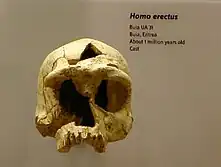Buya, Eritrea
Buya or Buia is an archaeological site in Eritrea. It is known for the discovery of Madam Buya, a one million year old fossil of a Homo erectus skull. This skull contained features of both Homo erectus skeletons, and Homo sapiens skeletons. It is the earliest example of a fossil with human features. Archaeologists have also uncovered large quantities of animal fossils at the area.
Archaeology

The site was discovered in December 1995 due to surveys of the area carried out following a prospection of the region in November of 1994.[1] Buya was excavated between 1995 and 1997 by archaeologist Ernesto Abbate working for the University of Florence alongside a team of Eritrean and Italian paleontologists from the National Museum of Eritrea, the Pigorini Museum,[2] and the University of Florence.[3] They unearthed fragments of the skeleton of the Homo erectus fossil Madam Buya. They were found inside ancient river and lake sediments located within the Danakil Depression.[3]
This skeleton consisted of the fossil consisted of a nearly complete cranium, two fragments of a pelvis, and two incisors. Archaeologists believe that this skeleton belonged to an individual between 18 and 22 years old.[2] The fossils found at the site were one million years old, and bared characteristics of both Homo erectus skeletons and Homo sapiens skeletons.[4] It has a oval neurocranium, massive brow ridge, and wide cheekbones. These traits are all characteristics of a Homo erectus fossil. It also has a cranium which is widest high on the vault, which is a human trait. Prior to this discovery, the earliest known fossil with human traits was a 600,000 year old Homo heidelbergensis skeleton from Bodo, Ethiopia.[3] The discovery is considered to have been an important source of information about the development of modern humans.[3][5][6]
Tsegai Medin working for the National Museum of Eritrea, conducted another excavation in 2011. Husein Omar, one of the excavators, discovered a set of molars dated from 650,000 to 1.4 million years ago. According to Medin, this discovery would provide a vital source of information about human development during this time period and would provide oppurtunity for further research in Eritrea.[7]
Geology and Geography
The Buya archaeological site is located in the Dandiero basin, which is the northernmost part of the Eritrean Danakil depression. It is named after the Buya village which is located 100 kilometers south-southeast of the port city of Massawa. The site of the human fossils found at the area is 12 kilometers southeast of Buya by the Alad wells and the Alid volcano.[1] The area west of Buya is covered by a metamorphic base of low grade dolomitic rock, marble, calcareous meta-sediments, and graphitic slate that came into contact with high grade kyanite schist, amphibolite gneiss and granite gneiss.[8][9]
Paleoecology
Numerous remains of flora and fauna have been found at the site. These fossils have been exposed on the ground due to erosion, volcanic activity, and climate changes.[2] The type of fauna found at this site is typical of Early Pleistocene East African faunas. Remains of extinct taxa from this time period found at the site include: Theropithecus oswaldi, Hippopotamus gorgops, Palaeoloxodon recki, Bos buiaensis, Kolpochoerus olduvaiensis, Kolpochoerus majus, and the Metridiochoerus modestus. Other remnants of extant taxa such as White rhinoceros, Grévy's zebra, Sitatunga, waterbuck, and the Spotted hyena have been identified. Remains of water-dependent taxa such as the hippopotamus, waterbuck, sitatunga, crocodile, African rock python, Nile monitor lizard, and pelomedusidae found in the area indicate the region consisted of moist grassland habitats situated nearby water. Bird fossils found in the region also imply the area had open water with reed beds nearby dry areas. One fossil of Ardeotis kori found in the area indicates that this could have been located near an ancient savanna with scattered trees.[1]
References
- Abbate, Ernesto; Bondioli, Luca; Collina, Carmine; Coppa, Alfredo; Delfino, Massimo; Ghinassi, Massimiliano; Libsekal, Yosief; Macchiarelli, Roberto; Martínez-Navarro, Bienvenido (2023), Beyin, Amanuel; Wright, David K.; Wilkins, Jayne; Olszewski, Deborah I. (eds.), "Buia, Eritrea", Handbook of Pleistocene Archaeology of Africa : Hominin behavior, geography, and chronology, Cham: Springer International Publishing, pp. 243–261, doi:10.1007/978-3-031-20290-2_14, ISBN 978-3-031-20290-2, retrieved 2023-10-21
- "Buya: the origin of the first Homo sapiens". Eritrea Ministry Of Information. 2012-11-23. Archived from the original on October 7, 2023. Retrieved 2023-10-21.
- Schuster, Angela (1998). "New Skull from Eritrea". archive.archaeology.org. Archived from the original on August 20, 2023. Retrieved 2023-10-21.
- Dong, Rui; Pei, Shaojun; Guan, Mengcen; Yau, Shek-Chung; Yin, Changchuan; He, Rong L.; Yau, Stephen S.-T. (2022). "Full Chromosomal Relationships Between Populations and the Origin of Humans". Frontiers in Genetics. 12: 5. doi:10.3389/fgene.2021.828805/full. ISSN 1664-8021.
- NgCheong-Lum, Roseline; Orr, Tamra (2020-04-15). Eritrea. Cavendish Square Publishing, LLC. p. 6. ISBN 978-1-5026-5578-3.
- "Eritrea: Discovery of New Fossil | ECSS | Eritrean Center for Strategic Studies". Archived from the original on June 5, 2023. Retrieved 2023-10-21.
- "Over 1.5 Million Year-old Human Skeleton Discovered in Buya, Eritrea". TesfaNews. 2011-12-25. Archived from the original on October 21, 2023. Retrieved 2023-10-21.
- Teklesenbet, Andemariam; Eysteinsson, Hjálmar; Karl Rosenkjær, Guðni; Karlsdóttir, Ragna (2010). "Resistivity Survey in Alid Geothermal Area, Eritrea" (PDF). Proceedings World Geothermal Congress: 1. Archived (PDF) from the original on October 21, 2023.
- Beyene, Andemariam (2012). "Multidimensional inversion of MT data from Alid Geothermal area, Eritrea; comparison with geological structures and identification of a geothermal reservoir" (PDF). University of Iceland: 5. Archived from the original (PDF) on August 16, 2017.
{{cite journal}}: Cite journal requires|journal=(help)